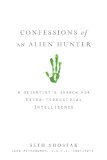SETI stands for Search for Extraterrestrial Intelligence. Initially a program supported by NASA, SETI is now a privately funded institute that conducts research activities to detect intelligent extraterrestrial life.
SETI Institute is currently collaborating with the Radio Astronomy Laboratory at UC Berkley to develop the Allen Telescope Array, which is a specialized radio telescope array designed for SETI studies.
Seth Shostak, senior astronomer at the SETI Institute, kindly answered a few questions related to the search for extraterrestrial intelligence.
DJ: Why did you choose to work for SETI?
Seth Shostak: It probably sounds too easy, and thoroughly trite, but I’ve been interested in the idea of extraterrestrial intelligence since I was ten years old. When, quite by chance, the opportunity arose to work for the SETI Institute, it was like finding that a dream was suddenly reality.
DJ: Besides listening for transmissions in the microwave range of radio frequencies, which methods do you think are most likely to prove successful for SETI?
S.Shostak: I happen to be a big fan of so-called Optical SETI, as well as traditional radio SETI. In other words, look for laser flashes that might be sent our way by extraterrestrial societies trying to get in touch. This would be a great way to initiate contact, as the transmitting civilization could “ping” many thousands — indeed, many millions — of star systems in short order, and then do it again. This would be a sort of endless ping to so many star systems that it might reliably generate some reaction. In any case, I think we need to expand our search for these quick flashes in the sky.
DJ: Is SETI looking only for carbon-based ET? Are there any other possibilities to consider when searching for extraterrestrial intelligence?
S.Shostak: SETI searches are agnostic when it comes to the biochemistry of the aliens. After all, from our point of view, what makes them “intelligent” is their ability to build a radio transmitter or a powerful laser. The details of their construction are of no consequence for the search — except insofar as they might not be living on planets surrounding an ordinary star. If they are machine intelligence, they may have migrated away from their natal solar system, and of course that WOULD affect our search strategies.
DJ: Do new discoveries made by astronomers using space telescopes (for example, discovery of exo-planets, detection of their atmospheres, and the study of the composition of these atmospheres using spectral lines, etc.) have any implications for the way SETI conducts searches? Is SETI using this information to fine-tune the search?
S.Shostak: One of the first SETI experiments planned for the Allen Telescope Array is to examine star systems that are known to have planets (the work of astronomers during the past dozen years). Of course, we would like to know which star systems have HABITABLE planets, but that information still eludes us. NASA’s Kepler Mission will give us invaluable insight into what fraction of the cosmos might be suitable for life — and life of the intelligent variety, as well.
DJ: How do you see a two-way communication with ET? What concepts can be considered universal so that they can be used for such communication?
S.Shostak: Given the likely distance between societies, I don’t think that two-way communication is very likely or practical. But there’s still the problem that any deliberate transmissions should be encoded in such a way that the recipients can figure out what is being said. Lots of thought has gone into this problem — should the aliens send dictionaries, mathematics, music, or just a lot of pictures? In general, I figure that the more information they send, the greater the chance that we’ll understand at least some of it.
DJ: Can you make a prediction as to when an ET radio transmission could be picked up by terrestrial receivers? Besides the pace at which terrestrial technology is evolving, what other factors should be considered when making such a prediction?
S.Shostak: The most important parameter affecting SETI success these days is money: do we have sufficient funds to keep up the search? But if the money is forthcoming, then technical developments in the coming decades will allow us to examine a million or more star systems by 2025 or so. I think a million star systems is the right number to expect success, so that’s my prediction — we’ll find ET by 2025. Otherwise, I’ll be disappointed and slightly embarassed.
Seth Shostakâs new book, Confessions of An Alien Hunter: A Scientistâs Search for Extraterrestrial Intelligence, tells the true story of SETI. The book contains answers to many questions about SETI: what frequencies are monitored, where the antennas are aimed, how we should respond if a signal is received, etc. By reading this book, I have learned a great deal about the search for extraterrestrial intelligence.
Paul Gilster of Centauri Dreams has posted a review of the book. I invite everyone to read it.











 Subscribe to our RSS feed
Subscribe to our RSS feed











Just a note to thank you for using “E.T.” instead of alien to refer to exo-life. Alien, though accurate has been converted ala science-fiction into unfriendly or dangerous space invaders. Now that we are more aggressively searching for E.T. (Kepler Mission) we need to impart a more friendly and peaceful connotation.
[…] Speaking of SETI, Orbital Hub presents a Q&A session with âalien hunterâ Seth Shostak, senior astronomer at the privately-funded SETI […]
[…] astroENGINE’s speculative piece on METI (transmitting to the stars) and Orbital Hub’s Q&A session with alien hunter Seth Shostak, author of the recently released Confessions of an Alien […]
Add A Comment